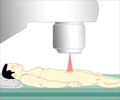To train the artificial intelligence to recognize prostate cancer, scientists have provided images from more than a million parts of stained tissue slides taken from patient biopsies.

‘The artificial intelligence demonstrated 98% sensitivity and 97% specificity at detecting prostate cancer, significantly higher than previously reported for algorithms working from tissue slides.’





To train the AI to recognize prostate cancer, Dhir and his colleagues provided images from more than a million parts of stained tissue slides taken from patient biopsies. Each image was labeled by expert pathologists to teach the AI how to discriminate between healthy and abnormal tissue. The algorithm was then tested on a separate set of 1,600 slides taken from 100 consecutive patients seen at UPMC for suspected prostate cancer. Also, this is the first algorithm to extend beyond cancer detection, reporting high performance for tumor grading, sizing and invasion of the surrounding nerves. These all are clinically important features required as part of the pathology report.
AI also flagged six slides that were not noted by the expert pathologists.
But Dhir explained that this doesn't necessarily mean that the machine is superior to humans. For example, in the course of evaluating these cases, the pathologist could have simply seen enough evidence of malignancy elsewhere in that patient's samples to recommend treatment. For less experienced pathologists, though, the algorithm could act as a failsafe to catch cases that might otherwise be missed.
"Algorithms like this are especially useful in lesions that are atypical," Dhir said. "A nonspecialized person may not be able to make the correct assessment. That's a major advantage of this kind of system."
Advertisement
Source-Eurekalert








![Prostate Specific Antigen [PSA] Prostate Specific Antigen [PSA]](https://www.medindia.net/images/common/patientinfo/120_100/prostate-specific-antigen.jpg)






